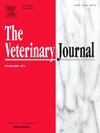通过网络药理学、小鼠模型和分子对接研究番茄红素通过MAPK通路对大肠杆菌感染引起的牛乳腺炎的治疗作用
IF 3.1
2区 农林科学
Q1 VETERINARY SCIENCES
引用次数: 0
摘要
大肠杆菌是一种机会致病菌,可引起急性牛乳腺炎,导致产奶量严重下降,乳制品被丢弃,并造成重大经济损失。这不仅危及奶牛的健康和农场的盈利能力,而且还引起了对食品安全的担忧,强调了有效治疗的必要性。番茄红素(LYC)是一种天然类胡萝卜素,具有有效的抗炎和抗氧化特性,已显示出减轻炎症性疾病的潜力。本研究通过网络药理学、分子对接和小鼠模型研究LYC对大肠杆菌诱导的牛乳腺炎的治疗机制。从TargetNet、GeneCards、CTD和SwissTargetPrediction中筛选LYC的潜在靶点,从GeneCards和CTD中分别获得乳腺炎和大肠杆菌感染相关基因。通过STRING和Cytoscape构建PPI网络,利用metscape数据库中的GO和KEGG分析核心靶点。通过分子对接验证LYC与关键靶点之间的结合亲和力。建立大肠杆菌诱导的乳腺炎小鼠模型,通过ELISA和Western blot检测炎症标志物和MAPK通路蛋白,评价LYC的疗效。网络药理学鉴定出LYC、乳腺炎和大肠杆菌感染之间的165个重叠靶点。KEGG分析强调MAPK通路是一个关键的信号轴,有15个核心调控因子。分子对接证实了LYC与这些核心调控因子的强结合。体内实验表明,LYC可显著减轻大肠杆菌感染小鼠的乳腺组织损伤,降低促炎细胞因子,抑制MAPK通路。因此,LYC通过调节MAPK通路减轻大肠杆菌感染诱导的牛乳腺炎,为乳腺炎治疗提供了一种有前景的天然替代方案。本文章由计算机程序翻译,如有差异,请以英文原文为准。
Lycopene exerts a treatment effect on bovine mastitis induced by Escherichia coli infection via the MAPK pathway using network pharmacology, a mice model and molecular docking
Escherichia coli, an opportunistic pathogen, induces acute bovine mastitis, leading to severe milk yield reduction, dairy product discard, and substantial economic losses. This not only jeopardizes cow health and farm profitability but also raises food safety concerns, highlighting the need for effective treatments. Lycopene (LYC), a natural carotenoid with potent anti-inflammatory and antioxidant properties, has shown potential in mitigating inflammatory diseases. This study investigated the therapeutic mechanism of LYC against E. coli-induced bovine mastitis using network pharmacology, molecular docking, and a mice model. Potential targets of LYC were screened from TargetNet, GeneCards, CTD and SwissTargetPrediction, while mastitis and E. coli infections-related genes were obtained from GeneCards and CTD, respectively. PPI networks were constructed via STRING and Cytoscape, and core targets were analyzed using GO and KEGG in Metascape database. Molecular docking was performed to validate binding affinities between LYC and key targets. An E. coli-induced mastitis mice model was established to evaluate LYC's efficacy, with inflammatory markers and MAPK pathway proteins assessed via ELISA and Western blot. Network pharmacology identified 165 overlapping targets among LYC, mastitis and E. coli infections. KEGG analysis highlighted the MAPK pathway as a critical signalling axis, with 15 core regulators. Molecular docking confirmed strong binding of LYC to these core regulators. In vivo experiments demonstrated that LYC significantly reduced mammary tissue damage, decreased pro-inflammatory cytokines, and suppressed MAPK pathway in E. coli-infected mice. Therefore, LYC alleviates E. coli infection-induced bovine mastitis by modulating the MAPK pathway, offering a promising natural alternative for mastitis treatment.
求助全文
通过发布文献求助,成功后即可免费获取论文全文。
去求助
来源期刊

Veterinary journal
农林科学-兽医学
CiteScore
4.10
自引率
4.50%
发文量
79
审稿时长
40 days
期刊介绍:
The Veterinary Journal (established 1875) publishes worldwide contributions on all aspects of veterinary science and its related subjects. It provides regular book reviews and a short communications section. The journal regularly commissions topical reviews and commentaries on features of major importance. Research areas include infectious diseases, applied biochemistry, parasitology, endocrinology, microbiology, immunology, pathology, pharmacology, physiology, molecular biology, immunogenetics, surgery, ophthalmology, dermatology and oncology.
 求助内容:
求助内容: 应助结果提醒方式:
应助结果提醒方式:


